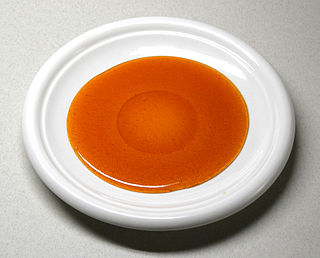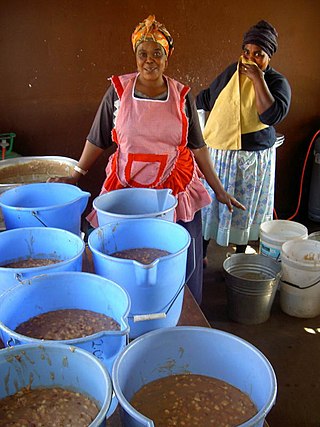External links
| Savoury dishes | |
|---|---|
| Snacks, condiments and commodities | |
| Pastries and desserts | |
| Drinks | |
| | This South African cuisine–related article is a stub. You can help Wikipedia by expanding it. |
Isidudu (Xhosa pronunciation: [Isidudu] ) is a soft porridge made from ground corn known as mealie meal. It is a common breakfast in Xhosa and Zulu households. It is served with sugar and milk. Some may prefer white/brown vinegar and sugar or butter/peanut butter and sugar etc. Sometimes the ground corn is fermented to have a sour taste.

Caramel is a confectionery product made by heating a range of sugars. It is used as a flavoring in puddings and desserts, as a filling in bonbons or candy bars, or as a topping for ice cream and custard.

Porridge is a food made by heating or boiling ground, crushed or chopped starchy plants, typically grain, in milk or water. It is often cooked or served with added flavourings such as sugar, honey, fruit, or syrup to make a sweet cereal, or it can be mixed with spices, meat, or vegetables to make a savoury dish. It is usually served hot in a bowl, depending on its consistency. Oat porridge, or oatmeal, is one of the most common types of porridge. Gruel is a thinner version of porridge and congee is a savoury variation of porridge of Asian origin.

Sweet corn, also called sweetcorn, sugar corn and pole corn, is a variety of maize grown for human consumption with a high sugar content. Sweet corn is the result of a naturally occurring recessive mutation in the genes which control conversion of sugar to starch inside the endosperm of the corn kernel. Sweet corn is picked when still immature and prepared and eaten as a vegetable, unlike field corn, which is harvested when the kernels are dry and mature. Since the process of maturation involves converting sugar to starch, sweet corn stores poorly and must be eaten fresh, canned, or frozen, before the kernels become tough and starchy.

Cornbread is a quick bread made with cornmeal, associated with the cuisine of the Southern United States, with origins in Native American cuisine. It is an example of batter bread. Dumplings and pancakes made with finely ground cornmeal are staple foods of the Hopi people in Arizona. The Hidatsa people of the Upper Midwest call baked cornbread naktsi, while the Choctaw people of the Southeast call it bvnaha. The Cherokee and Seneca tribes enrich the basic batter, adding chestnuts, sunflower seeds, apples, or berries, and sometimes combine it with beans or potatoes. Modern versions of cornbread are usually leavened by baking powder.

Fudge is a type of dessert bar that is made by mixing sugar, butter and milk. It has its origins in the 17th century United States, and became popular in American women's colleges in the late 19th century. Fudge can come in a variety of flavorings depending on the region or country it was made; popular flavors include fruit, nut, chocolate and caramel. Fudge is often bought as a gift from a gift shop in tourist areas and attractions.

A butter tart is a type of small pastry tart highly regarded in Canadian cuisine. The sweet tart consists of a filling of butter, sugar, syrup, and egg, baked in a pastry shell until the filling is semi-solid with a crunchy top. The butter tart should not be confused with butter pie or with bread and butter pudding.

Cachapa is a traditional dish made from maize flour from Venezuela. Like arepas, they are popular at roadside stands. They can be made like pancakes of fresh corn dough, or wrapped in dry corn leaves and boiled. The most common varieties are made with fresh ground corn mixed into a thick batter and cooked on a budare, like pancakes; the cachapa is slightly thicker and lumpier because of the pieces from corn kernels.
Farina is a form of milled wheat popular in the United States. It is often cooked as a hot breakfast cereal, or porridge. The word farina comes from the Latin word for 'meal' or 'flour'. Farina is milled from hard red spring or hard red winter wheat.
Hasty pudding is a pudding or porridge of grains cooked in milk or water. In the United States, it often refers specifically to a version made primarily with ground ("Indian") corn, and it is most known for being mentioned in the lyrics of "Yankee Doodle", a traditional American song of the eighteenth century.

Umngqusho is a South African dish based on samp and sugar beans, usually served with hard body chicken which is called umleqwa in isiXhosa. Traditionally a Xhosa staple meal, it has been adopted by other tribes in South Africa as their staple meal as well. This dish is a staple meal for most South African families, referred to as isitambu by the Zulu people and umngqusho by the Xhosa people.

Umqombothi, is a South African traditional beer made from maize (corn), maize malt, sorghum malt, yeast and water. It is very rich in vitamin B. The beer has a rather low alcohol content and is known to have a heavy and distinctly sour aroma. In appearance, the beer is opaque and light tan. It has a thick, creamy, and gritty consistency.

Samp is a food made from dried corn kernels that have been pounded and chopped until broken, but not as finely ground as mealie-meal or mielie rice. The coating around the kernel loosens and is removed during the pounding and stamping process. It is eaten across South Africa and by the Lozi and Tonga people of Zambia with sugar and sour milk. It can also be served with gravy and various additives. It is cooked with beans in the Xhosa variant of umngqusho and sometimes eaten with chakalaka. It can also be served with beef, lamb, poultry and in stuffings.

Crunchy Nut is a breakfast cereal made by Kellogg's with flakes of corn, honey, three types of sugar, and chopped peanuts. The product was created by Kellogg's employees at their Trafford Park factory in Greater Manchester and first introduced in 1980.

The Xhosa people( KAW-sə, KOH-sə; Xhosa pronunciation:[kǁʰɔ́ːsa] ) are a Bantu ethnic group and nation native to South Africa. They are the second largest ethnic group in South Africa and are native speakers of the isiXhosa language.

Duckunoo or duckanoo, also referred to as tie-a-leaf, blue drawers (draws), dokonon, and dukunou is a dessert in Jamaica, Haiti, Antigua and Barbuda, Belize, St Vincent, French Guiana and some other islands in the Lesser Antilles. It is a variation of tamale, which originated in Mesoamerica as early as 8000 to 5000 BC. The Caribbean dish which has Amerindian and African influences, is typically made from batata, coconut, cornmeal, spices like cinnamon and nutmeg, brown sugar and vanilla, all tied up in a banana leaf. It is then cooked in boiling water.

Puto seco, also known as puto masa, are Filipino cookies made from ground glutinous rice, cornstarch, sugar, salt, butter, and eggs. They are characteristically white and often shaped into thick disks. They have a dry, powdery texture.
Chechen cuisine is the traditional folk cuisine of the Chechen people, who dwell in the North Caucasus.

Binatog, also known as bualaw or kinulti, is a Filipino boiled corn dessert topped with freshly grated coconut, butter, and salt or sugar. It is commonly sold as street food in the northern Philippines by vendors known as magbibinatog carrying characteristic large tin cans, similar to taho vendors.